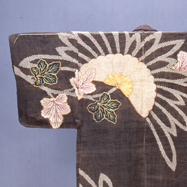Past Exhibitions
- Capital Style: The Elegance of Kosode Robes
- September 13, 2014 - October 19, 2014
The kimono has become a quintessential symbol of Japan. The origin of this shape of garment is the kosode--a robe that was first worn by aristocratic women as an under-layer beneath their formal court costumes, known as jūnihitoe ("twelve layer robes"). The term kosode (literally "small sleeves") refers to the robe's small sleeve openings, which were just big enough to fit an arm through. These contrasted with the large, loose sleeve openings of court costume sleeves, which were also so wide that they often covered the wearer's hands.
Having emerged as a more simplified form of dress and having been elevated from undergarment to outerwear, the kosode went on to become a platform for a rich variety of textile designs. This exhibition introduces the diversity of fashionable kosode from Kyoto, the trendsetting capital of Japan. Featured works include the Important Cultural Properties Kosode with Alternating Blocks of Flowers and Plants; Kosode with Small Motifs and Pine Bark Lozenge Bands; and Katabira (Summer Kimono) with Chrysanthemums and Fan Palm Leaves.












